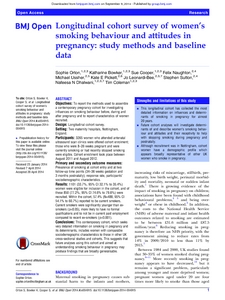Orton, S; Bowker, K; Cooper, S; Naughton, F; Ussher, M; Pickett, KE; Leonardi-Bee, J; Sutton, S; Dhalwani, NN; Coleman, T
(2014)
Longitudinal cohort survey of women's smoking behaviour and attitudes in pregnancy: study methods and baseline data.
BMJ Open, 4 (5).
e004915 (1) - -e004915 (9).
ISSN 2044-6055
https://doi.org/10.1136/bmjopen-2014-004915
SGUL Authors: Ussher, Michael Henry
![[img]](https://openaccess.sgul.ac.uk/107175/1.hassmallThumbnailVersion/BMJ%20Open-2014-Orton-.pdf)  Preview |
|
["document_typename_cannot open `/data/SGUL/sgul/eprints3/archives/sgul/documents/disk0/00/10/71/75/01/BMJ' (No such file or directory)
cannot open `Open-2014-Orton-.pdf' (No such file or directory)" not defined]
Published Version
Available under License St George's repository terms & conditions.
Download (1MB)
| Preview
|
Abstract
Objectives: To report the methods used to assemble a contemporary pregnancy cohort for investigating influences on smoking behaviour before, during and after pregnancy and to report characteristics of women recruited.
Design: Longitudinal cohort survey.
Setting: Two maternity hospitals, Nottingham, England.
Participants: 3265 women who attended antenatal ultrasound scan clinics were offered cohort enrolment; those who were 8–26 weeks pregnant and were currently smoking or had recently stopped smoking were eligible. Cohort enrollment took place between August 2011 and August 2012.
Primary and secondary outcome measures: Prevalence of smoking at cohort entry and at two follow-up time points (34–36 weeks gestation and 3 months postnatally); response rate, participants’ sociodemographic characteristics.
Results: 1101 (33.7%, 95% CI 32.1% to 35.4%) women were eligible for inclusion in the cohort, and of these 850 (77.2%, 95% CI 74.6% to 79.6%) were recruited. Within the cohort, 57.4% (N=488, 95% CI 54.1% to 60.7%) reported to be current smokers. Current smokers were significantly younger than ex-smokers (p<0.05), more likely to have no formal qualifications and to not be in current paid employment compared to recent ex-smokers (p<0.001).
Conclusions: This contemporary cohort, which seeks very detailed information on smoking in pregnancy and its determinants, includes women with comparable sociodemographic characteristics to those in other UK cross-sectional studies and cohorts. This suggests that future analyses using this cohort and aimed at understanding smoking behaviour in pregnancy may produce findings that are broadly generalisable.
| Item Type: |
Article
|
| Additional Information: |
Copyright Published by the BMJ Publishing Group Limited.
This is an Open Access article distributed in accordance with the Creative Commons Attribution Non Commercial (CC BY-NC 3.0) license, which permits others to distribute, remix, adapt, build upon this work non-commercially, and license their derivative works on different terms, provided the original work is properly cited and the use is non-commercial |
| Keywords: |
Epidemiology, Primary Care, Public Health, Epidemiology, Primary Care, Public Health |
| SGUL Research Institute / Research Centre: |
Academic Structure > Population Health Research Institute (INPH) |
| Journal or Publication Title: |
BMJ Open |
| ISSN: |
2044-6055 |
| Related URLs: |
|
| Dates: |
| Date | Event |
|---|
| 14 May 2014 | Published |
|
| PubMed ID: |
24833689 |
| Web of Science ID: |
24833689 |
 |
Go to PubMed abstract |
| URI: |
https://openaccess.sgul.ac.uk/id/eprint/107175 |
| Publisher's version: |
https://doi.org/10.1136/bmjopen-2014-004915 |
Statistics
Item downloaded times since 16 Sep 2014.
Actions (login required)
 |
Edit Item |



